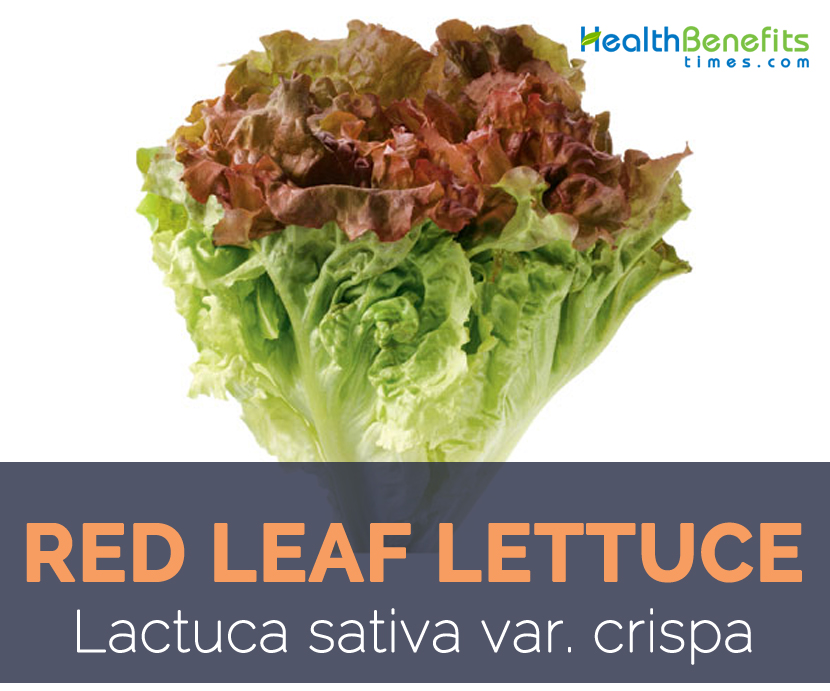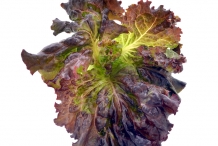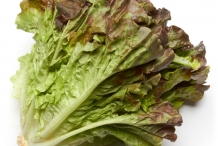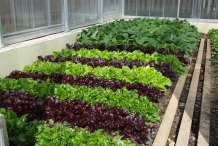Plant
Red leaf lettuce is similar to romaine lettuce, except it has red-tinged leaves. It is an herbaceous vegetable which is found growing in moist but well-drained, nutrient-rich soil. Normally it prefers full sun and cool weather. Red leaf lettuce has large, open “head” of loose leaves that deepens in color as it matures. Color of leaf vary from medium to dark-red in color mixing to nearly white ribs or veins. Leaves do not form heads and the leaves are a bright. The leaves can the frilled, curly or wrinkled. The texture is constantly crispy and succulent, the flavor generally mild and delicately earthy with a slightly bitter nuance which is perfect for salad. Red leaf Lettuce is one of the very low calorie green-vegetables and is an excellent source of several Vitamin A and beta carotenes as well as a rich source of vitamin K, vitamin C, and folates, whereas also containing lots of minerals like iron, magnesium, calcium and potassium, which are very essential for body metabolism.
History
The first cultivators of lettuce can be traced back 4500 years to the Egyptians. It is supposed that these first lettuces were derived from wild weeds. The cultivators were able to get wider leaves through time that was not bitter in taste. The ancient Greeks also consumed a lot of different types of lettuce as well. The Romans further extend the use of lettuce throughout Europe. Many varieties of lettuce were grown between the 14th and 16th centuries into their modern forms of today.
Similarly Asian countries only started cultivating lettuce in the last 100 years. However, currently China is the main producer of lettuce with over 52% of world production. The other top producing countries are United States, India, Italy and Spain. In the United States, California produces over 75% of domestic production. Arizona is the second-leading state with about 17% of national production.
Health benefits of Red Leaf Lettuce
Red leaf lettuce is a sweet and very delicately textured and flavored lettuce. Fresh leaves are an excellent source of several Vitamin A and beta carotenes as well as a rich source of vitamin K, vitamin C, and folates, while also containing lots of minerals like iron, calcium, magnesium, and potassium, which are very essential for body metabolism. Regular use of red leaf lettuce is one of the best methods to overall long term as well as short term illness.
1. Ensures Healthy Eyes
Vitamin A present in Red leaf lettuce aid in improving vision. It assists your eyes to modify to light changes, keeps the eyes moist, and also improves night vision. It is also beneficial for preventing dry eyes. Vitamin A of red leaf lettuce helps in formations of visual purple in eyes that improve the vision of weak eyes. Apart from that it ensures a healthy retina and prevents night blindness by increasing the adaptability of the human eye to both bright light and darkness. Regular consumption of red leaf lettuce also decreases the risks of cataracts and macular degeneration that is normally related with aging. It ensures healthy and beautiful eyes and is considered to be beneficial for people suffering from glaucoma.
2. Fights Cancer
Red leaf lettuce consists of considerable amount of Vitamin K which has been displayed to be effective in decreasing the risk of stomach, prostate, colon, nasal, and oral cancers. Research has discovered that high doses of vitamin K helped patients with liver cancer stabilize and even improve their liver function. Another research study showed that an increase in dietary intake of vitamin K is related with a reduced possibility of cardiovascular, cancer, or all-cause mortality in a Mediterranean population at high cardiovascular disease risk.
3. Healthy Bones
Manganese present in red leaf lettuce is essential for proper and normal development of human bone structure. It is a very effective mineral in helping in the increase of the mineral density of spinal bone. This is particularly true and beneficial for post-menopausal women. Several females suffer from manganese insufficiency after they go through menopause; therefore increasing the amount of trace minerals that women consume is an essential factor in preventing fractures. Though research has yet to constantly prove that manganese can avoid osteoporosis, it is assumed to be one of the contributing factors that slow down the progress of that debilitating disease.
4. Restless leg syndrome
Iron deficiency is one of the main causes of the restless leg syndrome. Several researches on this condition have focused on iron. Lower level of iron within the blood is a main reason and therefore proper consumption of iron supplements in essential levels as per doctor’s consultation can cure this problem. So include iron rich vegetables like Red leaf lettuce in your regular diet to fulfill iron deficiency and get rid of these problems.
5. Lowers Risk of Gout
Vitamin C helps in lowering the risk of Gout. Gout is actually a painful, arthritis type condition mainly afflicting the big toe. Normally big toe becomes rigid, inflamed and painful as a result of extra uric acid leading to crystals formed in joints. Vitamin C rich vegetable like red leaf lettuce is one of the main sources of vitamin c which helps to lower the risk of gout. Research which is done on males over age of 40 who use 1500 mg of vitamin c per day have nearly half the risk of getting gout in comparison with those who did not take supplements.
6. Mental and Emotional Disorders
Vitamin B9 present in red leaf lettuce is helpful in handling numerous mental and emotional disorders. For example, it is useful in treating anxiety and depression, which are two of the most common mental health problems suffered by people in today’s modern world.
7. Heart disease
Fiber, mainly soluble fiber, is an essential element of any heart-healthy diet. Consumption of diet high in fiber can increase cholesterol levels by lowering LDL (bad) cholesterol. A high fiber intake may also decrease your risk for metabolic syndrome, a group of risk factors linked to coronary heart disease, diabetes, and stroke. Fiber may help to lower blood pressure, reduce inflammation, improve levels of HDL (good) cholesterol, and shed excess weight around the abdomen.
8. Helps Treat Anemia
Vitamin B6 is necessary to create hemoglobin within the blood, that is transported by red blood cells throughout the body to help bring oxygen to cells and to mobilize iron. Anemia results as soon as someone doesn’t make sufficient red blood cells, leading to symptoms like fatigue, aches and pains, and more. Several researches show that consuming plenty of vitamin B6 can help lower symptoms of anemia and prevent it from occurring in some instances.
How to Eat
- Lettuce is often consumed raw in salads, but it can also be sautéed, braised, steamed and even grilled to make a different addition to an entrée or side dish.
- Add red leaf lettuce to a ham or turkey and cheese sandwich.
- In a taco salad, replace chips with red leaf lettuce.
References:
http://district.schoolnutritionandfitness.com/uplandusd/files/FFVP/RedLeafLettuce.pdf
http://www.foodterms.com/encyclopedia/red-leaf-lettuce/index.html
https://npgsweb.ars-grin.gov/gringlobal/taxonomydetail.aspx?id=404618
Comments
| Red Leaf Lettuce Quick Facts | |
|---|---|
| Name: | Red Leaf Lettuce |
| Scientific Name: | Lactuca sativa var. crispa |
| Origin | About 4500 years in Egypt |
| Colors | Medium to dark-red in color blending to nearly white ribs or veins (Leaf) |
| Shapes | Large, open “head” of loose leaves that deepens in color as it matures (Leaf) |
| Calories | 4 Kcal./cup |
| Major nutrients | Vitamin K (32.75%) Vitamin A (15.00%) Iron (4.25%) Vitamin B9 (2.50%) Manganese (2.48%) |
| Health benefits | Helps Treat Anemia, Heart disease, Mental and Emotional Disorders, Lowers Risk of Gout, Restless leg syndrome, Healthy Bones, Fights Cancer, Ensures Healthy Eyes |
| More facts about Red Leaf Lettuce | |
| Name | Red leaf lettuce |
|---|---|
| Scientific Name | Lactuca sativa |
| Name in Other Languages | Arabic: alkhasu nabaatan (الخس نبات) ; Chinese: wo ju (莴苣), wo ju (萵苣), sheng cai (生菜); Croatian: pitoma loćika, šalata; Czech: částech salátu, dārza salātus, dārza salāti, hlávkový salát, locika salátová, locika salát, salát; Danish: havesalat, salat; Dutch: bindsalade, sla; English: garden lettuce, lettuce; Finnish: ruokasalaatti, salaattii; French: laitue commune, laitue, laitue cultivée; German: batavia salat, gartensalat, gartenlattich, grüner salat, kopfsalat, salat; Greek: marouli (μαρούλι); Hebrew: chasa, chasa tarbutit; Hungarian: fejessaláta, kerti saláta, fejes saláta, leveles saláta, salàta; Italian: lattuga, insalata, lattùga coltivata; Japanese: chisha (チシャ) , retasu (レタス); Norwegian: hagesalat; Persian: khas; Polish: sałata siewna, sałata; Portuguese: alface; Russian: salat latuk (салат латук); Serbian: loćika, pitoma loćika, marula, salata; Slovenian: vrtna salata, virhovka; Spanish: lattuga coltivata, lechuga; Swedish: huvudsallat, sallad, laktuk, sallat, trädgårdssallat; Tagalog: letsugas; Vietnamese: salàt |
| Texture | Tender |
| Taste | Subtle |
| Flavor | Earthy, mildly sweet or semi-bitter |
| Major Nutritions | Vitamin K (phylloquinone) 39.3 µg (32.75%) Vitamin A, RAE 105 µg (15.00%) Iron, Fe 0.34 mg (4.25%) Vitamin B9 (Folate) 10 µg (2.50%) Manganese, Mn 0.057 mg (2.48%) Vitamin B6 (Pyridoxine) 0.028 mg (2.15%) Vitamin B2 (Riboflavin) 0.022 mg (1.69%) Vitamin B1 (Thiamin) 0.018 mg (1.50%) Tryptophan 0.006 g (1.36%) Phosphorus, P 8 mg (1.14%) |
| Calories in 1 cup shredded (28 g) | 4 Kcal. |






